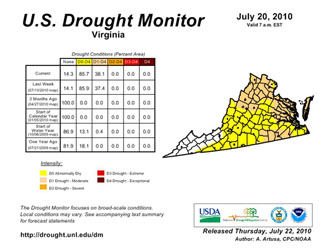Drought Watch for Summer 2010
The Virginia Department of Environmental Quality issued a drought watch in July for much of the state of Virginia for the summer of 2010. The issuance of the ‘Watch’ is dependent on a host of data that considers precipitation amounts, and measurements/observed levels of stream flow, groundwater, and reservoir levels. DEQ also defines and provides links to the Palmer Drought Severity Index, a numeric scale ranging from -4.0 (or less) for extreme drought to 4.0 (or more) for excessive moisture. The PDSI indicates the prolonged and abnormal moisture deficiency or excess. You can find detailed information on all of this information at the DEQ website at www.deq.state.va.us/.

A watch sets forth a series of steps that numerous state agencies implement to conserve water. Many of the measures set forth in a watch are ‘voluntary’ but they are certainly steps that all homeowners should take in standard lawn care practices. If the dry weather continues, a drought warning can be issued (with its own steps/requirements), and finally, a drought emergency where mandatory water use restrictions are implemented. During a drought emergency, there are a series of prohibited irrigation practices, some of which are related to standard lawn irrigation events. At the same time, there are common-sense allowances for newly established turfs, maintenance irrigation of golf greens, tees, and fairways, and irrigation to ensure safety and minimum playability standards of athletic fields.
We should ALWAYS follow some basic rules in irrigation, but it is especially critical to take appropriate steps when a drought watch is issued. Some basic water management/irrigation tips for lawns include:
- Irrigate in the early morning hours in order to improve irrigation distribution and reduce disease pressure from persistently wet turf and landscape foliage.
- Perform an audit on your irrigation system to ensure it is operating at peak performance; adjust and/or replace replace faulty heads.
- Install rain-out sensors on existing systems.
- Irrigate established turf deeply and infrequently (the rule of thumb is an inch of water per week and while this is not absolute depending on grass, soil, and climate differences, it is a pretty reasonable target for most situations), but only apply as much water as your soil will absorb in a single irrigation event.
- On cool-season lawns, mow the turf at the highest level possible (3 or more inches) OR keep the mower off of it until the turf resumes active growth.
- Consider letting the turf go dormant. Grass is amazingly resilient to moisture extremes.
There is a pdf attachment to this podcast that can be found at the Turf and Garden Tips website that details a series of responsible drought watch actions and a group of web resources for which links are provided. Water is one of our most precious commodities so be sure to do your share in using it responsibly in your landscape management program.


